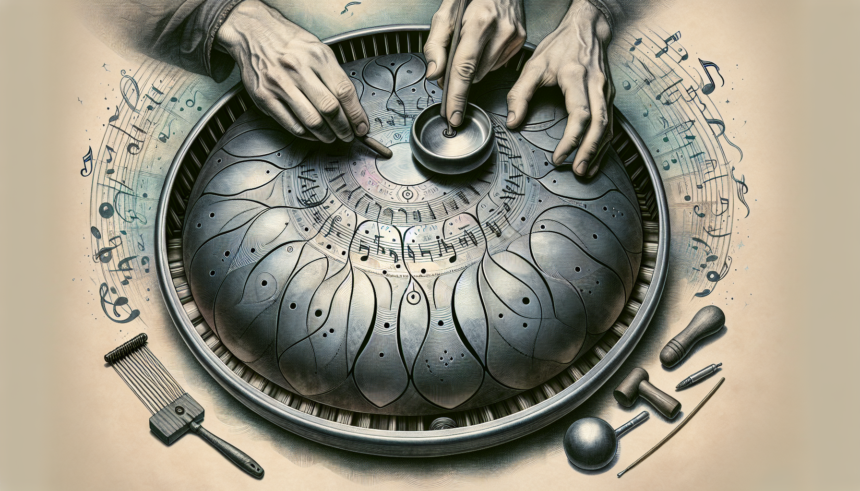The handpan, a mesmerizing melodic percussion instrument, has gained immense popularity since its inception. With its soothing and ethereal sounds, it captures the hearts of musicians and listeners alike. While owning a handpan is an experience in itself, customizing it by tuning and modifying harmonics takes that experience to another level. This article delves into the intricacies of handpan customization, offering insights into the process of tuning and harmonics modification.
Understanding Handpan Basics
Handpans typically consist of a central dome surrounded by several tone fields. Each field produces a specific note when struck. The most common scale for handpans is the pentatonic scale, but they can encompass a variety of scales and tunings. The unique sound of a handpan comes from its harmonics, which are overtones that resonate sympathetically with the primary note.
Tuning a Handpan
Tuning a handpan is a precise and delicate process. It involves intricate hammering and adjusting the tension of the metal to achieve the desired pitch and harmonics. Here are the essential steps and considerations involved in tuning a handpan:
1. Selecting the Right Tools
Before you start tuning, ensure you have the appropriate tools. These typically include:
- Tuning hammers: Used to adjust the tension of the metal and achieve the desired pitch.
- Electronic tuner: Helps you measure the frequency of the notes accurately.
- Microphone and audio software: Useful for analyzing the harmonics and overtones.
2. Understanding the Note Layout
Familiarize yourself with the layout of the notes and their corresponding pitches. It’s crucial to have a clear understanding of where each note is located and how they interact with each other harmonically.
3. Adjusting the Pitch
To tune a specific note, gently tap the edges of the tone field with a tuning hammer. Adjust the tension until the note reaches the desired pitch as indicated by the electronic tuner. It’s essential to make small and precise adjustments to avoid damaging the instrument or affecting adjacent notes.
4. Fine-Tuning Harmonics
Once the primary pitch is achieved, it’s time to fine-tune the harmonics. This involves identifying and adjusting the overtones. Using a microphone and audio software, analyze the harmonics and make small adjustments with the tuning hammer. Aim for a balance where the harmonics are in harmony with the primary pitch.
Modifying Harmonics
Modifying the harmonics of a handpan can significantly enhance its tonal richness and versatility. Here are key aspects to consider when modifying harmonics:
1. Understanding Harmonics
Harmonics are the secondary frequencies that resonate along with the fundamental note. These overtones add depth and character to the sound of the handpan. Common harmonics include the octave, fifth, and third intervals. Modifying these harmonics involves careful manipulation of the tone field to bring out or suppress specific overtones.
2. Natural vs. Altered Harmonics
Natural harmonics occur spontaneously as part of the instrument’s design. However, players can alter these harmonics to create unique soundscapes. This may involve slight adjustments to the tone field or incorporating additional elements like dampening materials to modify the resonances.
3. Experimenting with Overtones
Experimentation is key to discovering new harmonic possibilities. Try various techniques, such as:
- Muting: Lightly touching certain parts of the tone field while playing to suppress specific overtones.
- Resonance enhancement: Adjusting the tension or shape of the tone field to amplify desired harmonics.
- Custom scales: Creating unique scales by modifying the harmonics to fit specific musical aesthetics.
4. Seeking Professional Assistance
While minor modifications can be undertaken by skilled players, significant changes in harmonics or tuning may require professional assistance. Seek out experienced handpan tuners who have the expertise and tools to make precise modifications without compromising the instrument’s integrity.
Customizing your handpan through tuning and modifying harmonics can be a deeply satisfying and creative endeavor. Whether you’re a seasoned musician or a passionate enthusiast, understanding and exploring the intricacies of your handpan’s sound can open up new realms of musical expression.
Conclusion
In conclusion, the handpan is not just an instrument; it is a gateway to a world of unique soundscapes. Customizing your handpan by tuning and modifying the harmonics allows you to tailor its sound to your precise musical needs and preferences. From the meticulous process of adjusting pitches to the fascinating exploration of overtone manipulation, the journey of handpan customization is as rewarding as it is intricate. Keep in mind that while DIY efforts can yield satisfying results, there is always a benefit to consulting with a professional for more significant modifications. As you venture into this realm of customization, remember to experiment, listen, and allow your handpan to reveal its full melodic potential.
FAQs
1. Can I tune my handpan at home?
Yes, it is possible to tune your handpan at home if you have the right tools and a good understanding of the process. However, it’s a delicate task that requires precision, so practicing on a less valued instrument first can be beneficial.
2. How often should I tune my handpan?
The frequency of tuning depends on how often you play and the environmental conditions it’s exposed to. Generally, once a year is sufficient, but it might need more frequent tuning if played extensively.
3. What scales can I choose for my handpan?
There are numerous scales you can choose from, ranging from minor scales like Kurdi and Celtic Minor to major scales like Integral and Major Pentatonic. The choice depends on your musical preferences and the mood you wish to create.
4. Can I modify the harmonics of my handpan myself?
Minor modifications and experiments with harmonics can be done at home. However, for significant changes, it’s advisable to seek professional assistance to avoid damaging the instrument.
5. How do I know if my handpan is out of tune?
You can use an electronic tuner to check if the notes match their intended pitch. Additionally, if you notice a lack of coherence or a “wobbling” sound when playing, it might indicate that the handpan is out of tune.





